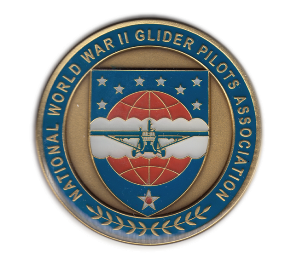National WWII Glider Pilots AssociationLegacy Organization of veterans National WWII Glider Pilots Association. Discover our History, Preserve our Legacy | ||
|
Although both the U.S. Army and Navy had tinkered with gliders, the Army in 1923 and the Navy in 1930, both had abandoned them long before WW II. Official knowledge of glider design and operation, therefore, was absolutely zero. The only U.S. glider experience was to be found in the sport soaring movement, which was supported by a very small glider industry. It was to these people that the Army turned after Air Corps Commander General H.R. Arnold issued orders for the development of troops gliders and the procurement of suitable training gliders on February 25, 1941. It was the performance-minded soaring people, therefore, who influenced early U.S. military glider design. Early Army purchases of training gliders (TGs), which began in April, 1941, were off-the-shelf commercial sailplanes and the first new trainers designed specifically for the services were also sailplanes. The initial orders to three established glider manufacturers, Frankfort, Schweizer, and Laister-Kauffman, were supplemented by the purchase of practically all the privately-owned sailplanes in the country to get the new glider training program rolling. The four production TG models that the Army ordered were the Frankfort TG-1, Schweizer TG-2 and TG-3 and the Laister-Kauffmann TG-4. Aeronca, Taylorcraft and Piper joined in by converting existing powered aircraft into training gliders by removing the engine and modifying them by adding a third tandem seat. In the Army's original and entirely logical concept, glider pilots would be existing power pilots. However, the shortage of such personnel at the time called for a drastic revision of policy, especially after Arnold's request for glider pilots was upped to 6000 early in 1942. Offers were made to enlisted men with no flying experience at all, with the promise that they would graduate as staff sergeants. Those with rank above private would go through training in their grade and become sergeants at the end. Those with previous flying experience were also sought, and this policy brought in a lot of washouts from power pilot training. In the U.S. services the glider pilots, whether unwarranted or not, were considered a notable cut below power pilots. They had a separate rating of Glider Pilot, with appropriate "G" wings, and were originally mostly sergeants, plus a very few commissioned pilots. Later all glider pilot graduates were awarded the Flight Officer rank. They were pilots only, unlike their German and British counterparts, who were trained to operate as infantrymen after landing. To familiarize Army Air Corps pilots with glider flying, some power pilots were sent to various existing civilian glider schools early in 1941. The object of these schools was to turn out soaring pilots, not aerial truck drivers, and the early Army Air Corps trainees ended up as accomplished sailplane soarers. An early decision was made to have the future glider pilots trained under contract to civilian schools. The main operation got under way at Twenty-Nine Palms, out in the California desert, where thermal conditions were great for soaring flights. Sailplane thinking still prevailed. By being able to soar - gain altitude on rising air currents - and therefore stay up longer on a given flight, the student would conceivably receive more instruction per flight. It was not long, however, before the military woke up to the fact that troop gliders were not simply bigger sailplanes that made long straight glides into enemy territory. They were, rather, low-performance trailers that had to be towed to a point almost directly over the landing area, and once over the designated spot, the real piloting skills necessary to reach the ground quickly in one piece, took over, if one wanted to survive. Sailplanes, with their long flat glides in the range of 20 or 30 to one, plus their entirely different handling characteristics, were of little value in familiarizing pilots with troop carrying gliders. Further, they were not really an efficient vehicle for turning out skilled pilots quickly. As a consequence, the sailplane trainers were abandoned as soon as sufficient quantities of the CG-4A were available for advanced training. In the interim, several advanced training bases were established: Bergstrom, Dalhart and Lubbock, TX, Bowman, KY, Fort Sumner, NM, Greenville, SC, Lockbourne, OH, Stuttgart, AR and Victorville, CA. A major percentage of glider pilots were graduated from South Plains Army Air Base at Lubbock, TX. In addition to basic and advanced glider flight training, a large number of trainees completed the glider mechanics course at Sheppard Field, TX and most glider pilots received the equivalent of the Infantry Officer training. |
TACTICAL GLIDER TRAINING
COMBAT INFANTRY TRAINING
17th AIRBORNE at
OGBOURNE ST. GEORGE
GLIDER PARATROOP JUMP
FEASABILITY TESTING
&&
A UUNIQUE GLIDER TOW -- PARACHUTE EXCERSICE IN SICILY
First published in the 23/24 Winter BRIEFING.
ACCOUNTS (Stories/Accidents)
TRAINING SCHOOLS
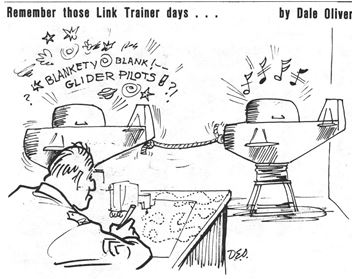
Drawn by Dale Oliver for the National WWII Glider pilots Association Newsletter, Silent Wings.
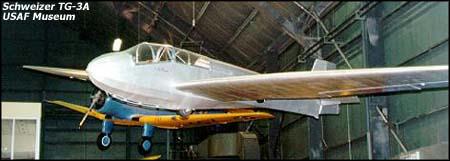
Schweizer TG-3
A TG-3 is on display in the US Air Force Museum
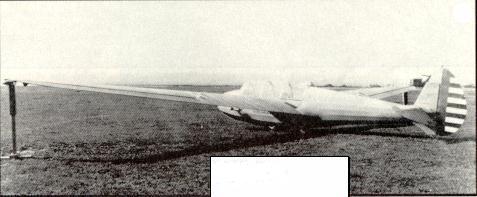 Laister-Kauffman TG-4
Laister-Kauffman TG-4A TG-4 is on display in the Silent Wing Museum in Lubbock, Texas.
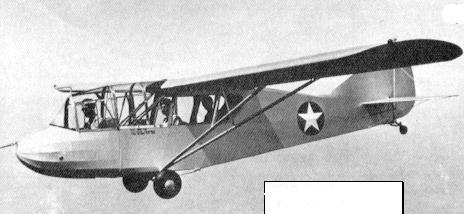 Aeronca TG-5
Aeronca TG-5USAAF photo courtesy US Air Force Museum
A completely restored TG-6 is on display in the Pima Air Museum, Tucson, AZ.
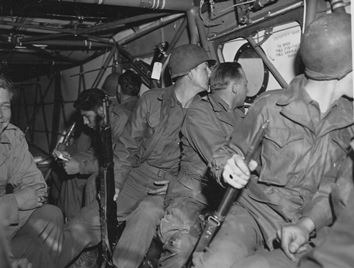 Courtesy of the National Archives / NWWIIGPA Collection
Courtesy of the National Archives / NWWIIGPA CollectionTraining was always on going even after they earned their wings. When not in combat pilots practiced landing with troops and equipment. Back Caption: Credit...U S Army Signal Corps/Photog...T/4 Jack Clemmer (3264)
Troopers of the 82nd Airborne division making a practice flight in a glider over france peer out of portholes at the ground far below, except for one nonchalant soldier who takes advanage of the inactivity to catch up on his reading. Laon, France 15 March [1945].

